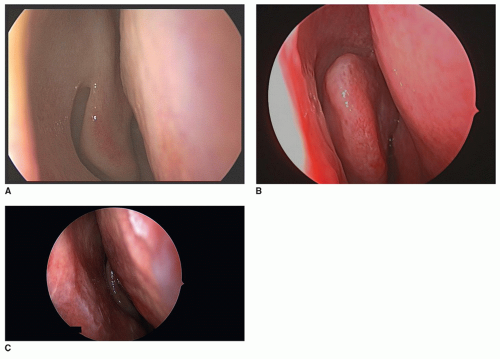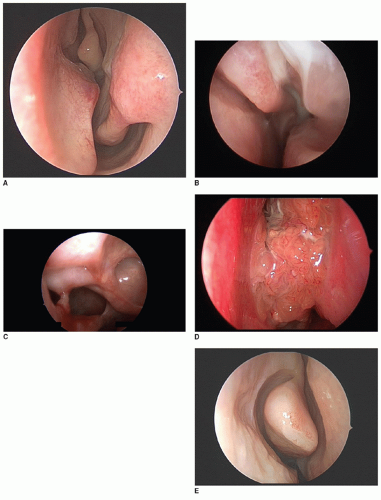Although most patients with sinonasal pathology do not require routine lab testing, there are certain clinical scenarios whereby the information obtained from lab results can be imperative to the diagnosis and subsequent treatment success. A common scenario where lab testing is indicated is during the evaluation of a young patient with sinus disease and any patient with refractory CRS. Lab testing can identify an underlying congenital abnormality, such as cystic fibrosis (CF) or primary immunodeficiency, or acquired illnesses such as atypical infections and systemic inflammatory diseases.
Cystic Fibrosis Testing
The diagnostic criteria for CF requires the presence of clinical symptoms consistent with CF in at least one organ system, and objective evidence of cystic fibrosis transmembrane conductance regulator (CFTR) dysfunction on any of the following three tests: (a) elevated sweat chloride greater than 60 mmol/L (on two occasions), (b) presence of two disease-causing CFTR mutations on DNA testing, or (c) abnormal nasal potential difference (NPD).
The sweat chloride test remains the primary test used for laboratory confirmation of CF. Sweating is induced by a technique called pilocarpine iontophoresis. It involves placing a pilocarpine-soaked gauze on the skin and applying a gentle electrical current. The current draws pilocarpine into the skin and induces sweat gland secretion. The sweat is then collected and the chloride concentration is quantified (
11). For infants older than 6 months, children, and adults, there are three groups of results: (a) Normal (CF very unlikely): ≤39 mmol/L, (b) Intermediate (Possible CF): 40 to 59 mmol/L, and (c) Abnormal (diagnosis of CF): ≥60 mmol/L. The accuracy of sweat chloride testing is operator-dependent and should be performed at experienced labs (
12). Patients with an intermediate sweat chloride result should receive DNA analysis, using the multimutation method, to identify a CFTR gene mutation. Approximately 20% of patients with an intermediate sweat test will have an identifiable CFTR mutation on DNA analysis (
13). If two CFTR mutations are not identified, then the sweat chloride test should be repeated. A false positive sweat test can occur in any of the following: (a) lab error, (b) malnutrition, (c) dehydration, (d) adrenal insufficiency, (e) hypothyroidism, (f) hypoparathyroidism, (g) mucopolysaccharidosis, and (h) nephrogenic diabetes insipidus. The two most common causes of a false negative sweat test are: (a) lab error and (b) skin edema.
Multimutation genetic testing involves screening at least 23 CF-causing CFTR mutations (
14). This panel identifies approximately 90% of CF causing mutations. Molecular analysis should be ordered in cases with an intermediate sweat chloride test. An expanded CFTR mutation panel, deletion evaluation, and/or direct gene sequencing is available for cases when a genetic screen failed to identify
two CF-causing mutations and a repeat sweat test was intermediate (40 to 59 mmol/L).
The NPD measures CFTR function within the nasal respiratory epithelium. The technique involves the following three measurements of the potential difference across the nasal epithelium: (a) basal state, (b) after nasal perfusion with amiloride (blocks sodium transport—the major component of the NPD), and (c) after nasal perfusion with a chloride-free solution containing isoproterenol (a camp agonist—stimulates CFTR chloride transport). Patients with CF will demonstrate a high basal state potential difference, a large decline with amiloride, and minimal response to isoproterenol. Although not widely available, measuring the NPD is useful in cases where the sweat test and genetic analysis results are inconclusive but atypical CF is suspected due to clinical presentation in one or more organs.
Other rare tests for CF include pancreatic function analysis, such a 72-hour stool collection for fecal fat analysis. Pulmonary function tests and bronchoalveolar lavages can be helpful to define the extent of pulmonary disease.
Primary Immunodeficiency Testing
Immunologic testing can evaluate both the cellular and humoral immune systems. Immune dysfunction is common in patients with refractory CRS (
15), therefore, knowledge of the available immune testing options is important.
Humoral immunity testing involves both quantifying immunoglobulin (Ig) levels and assessing for a functional immunoglobulin deficiency. Measurements of serum IgG, IgA, and IgM along with IgG subclasses are helpful to quantify a humoral deficiency. The significance of an IgG subclass deficiency remains controversial, while current recommendations state that it is not significant unless it is associated with an impaired specific antibody response. A functional immunoglobulin deficiency is evaluated by assessing the antibody response following administration of an unconjugated polysaccharide vaccine, such as pneumovax. For adults, a functional immunoglobulin deficiency is diagnosed if there was a lower than fourfold increase in antibody titers to 70% of the serotypes tested (
16).
Cellular immunity is mediated by T cells and deficiencies with this system often result in severe infections. The complete blood count (CBC) is useful to identify a lymphopenia and other hematologic defects. Flow cytometry uses cell surface markers to evaluate lymphocyte subpopulations and provide subset quantitative information. The cutaneous delayed-type hypersensitivity test is an in vivo test measuring the recall response to an intradermal injection of an antigen, which the patient has previously been exposed.





